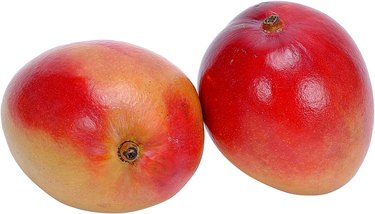
If you want to enjoy a bounty of your own, home-harvested mangoes (Mangifera indica), you will need to allow for time for the fruit to develop after blooming. Using the months or days after blooming and ripeness characteristics will help you to know when your mango tree's harvest season is. These indications are better than relying on the month or season of the year to base your harvest, because the harvest season time depends on where the mango tree is grown. While mango trees are not native to the United States, they are also not considered to be invasive plants. For the greatest chances of success with growing mango trees, you should live in U.S. Department of Agriculture plant hardiness zones 10b through 11.
Seasons
Video of the Day
The harvest season for mangoes ranges from the middle of the summer to the winter, depending on your location and variety of mangoes you grow. The majority of mangoes will be ready for picking during the late summer and autumn.
Video of the Day
Days After Harvest
The number of days after harvest is a better predictor for planning your harvest than the general season. Most mangoes are ready to be picked after 100 to 150 days following the tree's blooming. Your location and climate will determine when a mango tree blooms. For instance, in coastal Mediterranean climates, mangoes do not bloom until April for a harvest in October, but in warmer inland areas, blooming starts in January, and you often can pick the fruit in June.
Ripeness Characteristics
When you harvest mangoes will depend on how the fruit appears and feels. Ripening mangoes progress in color from green to yellow with a reddish blush, but the exterior color is not the best way to tell if the mango is ripe. The interior flesh color is a better indicator. Fully ripened mangoes will have a yellow or orange interior. If you can pluck a mango from the tree with little effort, it is likely ripe and ready, but if you need to pull hard on the mango, wait a while before picking it to let it ripen some more. Mangoes have been likened to peaches of the tropics, and, like peaches, mangoes soften as they ripen. Apply gentle pressure to mangoes on the tree to test for softness. Ripe mangoes should have a texture like fully ripened peaches. Picking the fruit while green is possible if you need to harvest the fruit early due to coming cold weather. Just let the green, mature mangoes ripen at room temperature.
Harvest and Storage Tips
When harvesting mangoes, be aware of the irritating sap that comes out of the stems of the fruit. It is also in the skin of under-ripe fruit. This sap can cause a reaction similar to a poison ivy rash several hours after exposure. Avoid this by wearing gloves when handling mangoes and before and during harvest, and thoroughly wash off the fruit after harvest to remove any residual sap. California Rare Fruit Growers, Inc., recommends harvesting mangoes in waves. The first wave is harvested when a group of mangoes changes to its mature color on the tree. All of the fruits that are the same size as those that have changed color, and any larger ones, are picked. Repeat this process over the coming weeks until the tree no longer has any mangoes on it. The harvested, fully ripened mangoes need to be stored at 55 degrees Fahrenheit, and green or partially ripe mangoes should be kept at 50 degrees Fahrenheit, according to the University of California, Davis, Postharvest Technology division.
- California Rare Fruit Growers, Inc.: Mango Mangifera Indica
- Harvest to Table: Mango: Kitchen Basics
- University of California, Davis, Postharvest Technology: Mango: Recommendations for Maintaining Postharvest Quality
- Purdue University New Crop: Mango
- University of Florida IFAS Extension: Mangifera Indica: Mango